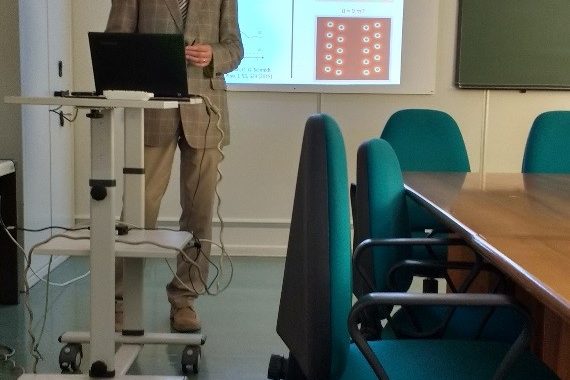
STSM of Prof. Vladimir Fomin at Università di Napoli
Prof. Vladimir Fomin [Institute for Integrative Nanosciences (IIN), Leibniz Institute for Solid State and Materials Research (IFW) Dresden] and his collaborators possess extensive experience in topology- and-geometry-driven effects in advanced micro- and nanoarchitectures. Advances in the high-tech fabrication methods have provided qualitatively novel curved micro- and nanoarchitectures of superconductors, e.g., nanostructured microtubes, helical microcoils and their arrays. Their superconducting properties as well as possible applications remain largely terra incognita. Rolling up a superconductor Nb nanomembrane into open tubes and helical microcoils allows for a new, highly correlated vortex dynamics regime that reveals a surprising (by a factor of 3) increase of a critical magnetic field for the beginning of vortex motion and a transition magnetic field between single- and many-vortex dynamic patterns in an open nanotube. Prof. Francesco Tafuri (Università di Napoli) and his group possess recognized expertise in Josephson effect, tunneling and phase-slip phenomena in unconventional, hybrid and nanostructured superconducting junctions, including behavior of Josephson junctions at high critical current densities, Josephson and charging effect in mesoscopic superconducting devices, statistics of localized phase slips in tunable width planar point contacts, flux-flow instabilities in nanowires.
Prof. Vladimir Fomin successfully performed his STSM at Università di Napoli “Federico II” from October 13 until October 20, 2018 by combining the complementary knowledge of the both groups in the ongoing exploration of phase-slip-related phenomena in advanced nanoachitectures as prototypes of hybrid devices for superconductor quantum technologies. Prof. Fomin gave an invited talk “Topology- and geometry-driven effects in superconductor rolled-up nanoarchitectures” at the Seminar of the Dipartimento di Fisica “E. Pancini”, Università di Napoli “Federico II” on October 17, 2018.
In the course of his STSM, Prof. Fomin conducted intensive discussions with Prof. Dr. F. Tafuri, members of his group Dr. D. Massarotti, Dr. G. Papari, Dr. D. Stornaiuolo, Ph.D. student A. Miano and collaborators of the Dipartimento di Fisica “E. Pancini” at Università di Napoli “Federico II” Prof. Dr. A. Tagliacozzo, Dr. G. Campagnano, Prof. Dr. V. Cataudella and Prof. Dr. G. De Filippis. The key issues of the interactions were: (i) properties of superconductor open microtubes at elevated transport currents, (ii) physical conditions of detection of flux-flow instabilities that have been observed in nanowires of different widths, showing sudden voltage switching jumps, (iii) methods of investigation of statistics of localized phase slips in planar point contacts of tunable width and (iv) fluxiod quantization phenomena in superconductor quantum rings with leads. Prof. Fomin presented the new theoretical findings on the properties of superconductor open microtubes, fabricated by self-organization roll-up high-tech at the IIN, IFW Dresden, at elevated transport currents in the regime close to the critical current densities, which allow for an efficient geometric control over the transport in superconductor nanoarchitectures. The related brainstorming was aimed at finding appropriate ways to extend the experimental and theoretical experience available in the group of Prof. Tafuri for Josephson junctions, superconductor nanowires and point contacts to the study of the superconducting states in the open superconductor nanostructured microtubes. Their application requires a dedicated measurement and analysis of current-voltage characteristics of the microtubular samples. The theoretical analysis of the topology-driven effects is needed for getting the further insight in non-equilibrium processes in superconductor nanowires.
As a result of the interactions during the present STSM of Prof. Fomin, a paper has been prepared and published: G. P. Papari and V. M. Fomin, Interplay between the quantum interference and current localization phenomena in superconductor non-ideal mesoscopic rings, Supercond. Sci. Technol. 32, 105008, 1-9 (2019). In this paper, a mean-field approach is proposed to describe the fluxoid dependence of magnetoresistance oscillations measured on two YBa2Cu3O7−x nanorings. The relation is unveiled between the quantum interference processes and current localization phenomena in superconductor nanorings, which are non-ideal because of the presence of stubs. The model, based on the change in supercurrent transmission due to fluxoid dynamics, provides a dependence of the measured differential voltage on the external magnetic field. In particular, the signature of the Little and Parks effect results from phase dynamics involving the transmission of probe currents crossing the ring, while magnetoresistance background is related to the screening currents dynamics driven by vortex nucleation. The model allows for tracing out the entire magnetoresistance, which is the result of the superposition of single vortex-like topological defects involving current localization. This approach provides a new conceptual frame to explain the Little and Parks effect that does not invoke the lowering of superconducting stiffness.
